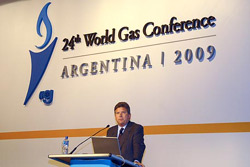How gas can change the world
on
How gas can change the world
The astonishing potential of “unconvential” gas reserves means that we have to move beyond regarding natural gas as merely a “bridge fuel”. Instead, gas should be seen as a “fundamental fuel in a low-carbon world”. That was the clear message from the global gas industry at the recent World Gas Conference in Buenos Aires. Now the question for the industry is how to get this message to policymakers who are only looking at renewables and nuclear energy.
 |
| Gas drilling well in Barnett shale, Texas, US |
| Article Highlights: |
| - Gas may be on its way to become the most important worldwide source of energy |
| - The advantage of gas over oil and coal is that its use leads to considerably lower CO2-emissions |
| - Moreover, because of its flexibility, gas-fired electricity is an ideal source of back-up power for renewables such as wind and solar power |
| - Perhaps most significantly, the spectacular development of unconventional gas sources, led by the US, means there will be much more gas available to the world than had been assumed until recently |
| - This last means that the problem of becoming too dependent on suppliers such as Russia will become a lot less acute |
Hayward was by no means a lone voice in Buenos Aires. The argument he put forward was advanced by several other senior executives – and was the subject of a special report (“Natural Gas Unlocking the Low-Carbon Future”), produced by the International Gas Union, the association of national trade associations and major energy companies that organises the triennial WGC. The IGU’s report put it like this: ‘If by magic we could switch all the world’s coal-fired power plants to modern natural gas-fired combined cycle plants, we would experience a reduction of emissions of over 5 billion tonnes of carbon dioxide per year – one-fifth of global CO2-emissions.’
The gas industry has been proclaiming natural gas’s potential as “a bridge fuel” to a sustainable energy economy for well over a decade - but has mostly been preaching to the choir. In Buenos Aires, industry executives went a step further. They said they felt the world needed to move beyond regarding natural gas as merely “a bridge fuel”. As Hayward put it, gas needed to be seen as ‘a destination fuel ... a fundamental fuel in a lower-carbon world’.
Game-changers
Since the last WGC took place in Amsterdam in 2006, three key developments have emerged to shape a radically different future for the industry. One has been the widespread acceptance that climate change could pose a grave threat unless action is taken to control anthropogenic greenhouse gas emissions. The second has been technological innovation that has made feasible the development of prolific unconventional gas reserves. The third has been the exceptionally rapid growth of the LNG industry, which is entering a period of relative maturity, as new projects employing larger production trains and larger ships increase the influence of LNG in global gas trade.
These three developments have huge implications, especially if considered in combination with each other:
- The climate change issue could lead to much greater demand for gas than has been assumed up until now.
- The stunning development of unconventional gas means that an abundance of gas ought to be available to meet such demand.
- The growth of LNG provides a transportation vector that acts as a globalising force between what up to now have been regional markets, with a reach and a level of flexibility that trans-national pipelines cannot match.
Rune Bjørnson, Statoil’s executive vice-president for natural gas, spoke of climate change, unconventional gas and LNG as the “three game-changers” that would shape the gas industry’s future. ‘If we ever doubted that gas is the fuel of the future, in many ways there’s the answer,’ he said.
Self-serving message
Commenting on the astonishing rise of unconventional gas in the United States, Antonio Brufau, chief executive of Repsol YPF, speculated that it would be only a matter of time before the technology developed there would be used in other regions. ‘Globally it is estimated that there are around 900 Tcm (trillion m3) of unconventional gas resources’, Brufau said. To put this figure in context, total world proven gas reserves at the end of 2008 were 185 Tcm, according to BP’s latest Statistical Review of World Energy. As Brufau commented: ‘Although there are doubts about what is technologically and economically feasible, the magnitude of this figure changes any long-term view. The marginal costs of unconventional gas create a new supply curve.’
| The choices for utilities boil down to two: coal or gas |
Of course gas does still contribute significantly to global warming, whereas renewables, nuclear energy and carbon capture and storage (CCS) do not. But, as Hayward explained, over the short-to-medium term the carbon-free options cannot hope to make sufficient contributions to mitigating greenhouse gas emissions to put the world on a trajectory that will keep global warming to within a 2ºC rise over pre-industrial levels. There is a broad consensus that this is an acceptable upper limit that would avoid disastrous climate change.
According to Hayward there are three reasons, then, why gas is the only realistic way to mitigate climate change in the short-to-medium term: first, over the long term the world’s energy needs will continue to rise inexorably; second, renewables, nuclear and CCS - vital as they will be in the long-term - cannot meet the immediate and urgent challenge of reducing carbon emissions quickly enough; and third, if it comes to a choice between gas and coal, gas is the lesser of two evils.
| I don’t believe we will see the commercial use of CCS at scale for at least another decade |
In the realm of alternatives, said Hayward, ‘promising too much too soon is dangerous. It risks rendering the entire global effort – both politically and economically – unsustainable. We can’t afford to wait. We need to take carbon out of the energy mix today. And we need to be realistic about how we’re going to achieve that. Until renewables gain a sizeable share of the power sector, and cleaner coal is available through CCS, I can see only one way of doing it: by increasing the use of natural gas. Gas is the fuel that offers the greatest potential to provide the largest reductions at the lowest cost – and all that by using technology that’s available today. If we get it right, gas can transform the global energy outlook.’
Dash for gas
The consensus within the gas industry is that such a transformation, favouring gas, is not only necessary, but also achievable. Non-hydro renewables such as wind and solar power currently contribute less than 2% of the world’s primary energy. So although they are growing fast they start from a tiny base. Meanwhile, expectations are that when the economic crisis has passed energy demand will grow robustly over the long term, as the world’s population grows. BP projects that by 2030 the world will need 45% more energy than today and that four-fifths will come from coal, oil and gas.
Even in countries where non-hydro renewables have a substantial share of the primary fuel mix, they have the problem of intermittency. So they need back-up from sources of electricity that can follow real-time changes in load. Gas-fired power stations are much better at this than coal or nuclear ones. Spain, for example, has 17 GW of wind power capacity but still needs backup from its CCGTs (combined-cycle gas turbines) when the wind isn’t blowing.
Nuclear power’s much-trumpeted renaissance means that eventually it may make a big contribution towards low-carbon electricity generation. However, its impact between now and 2020 will be small, especially in OECD countries, because it takes so long to approve and construct new projects. In the UK, for example, energy companies have been falling over each other in the rush to buy land for nuclear power stations. However, the earliest that a new project might come on line is 2018. More likely, according to one industry source, is the early 2020s. Some observers expect another “dash-for-gas” in the UK from around the middle of the next decade as many of its ageing power stations are forced to retire. Chances are that by 2020, nuclear power will be providing much less of the UK’s electricity than it does today.
| The gas industry is frustrated that it has not got the attention it deserves in Obama’s policy pronouncements |
Hayward reeled off a long list of the advantages of natural gas over coal when it comes to electricity generation. Modern gas-fired CCGTs have efficiencies of up to 60%. They are relatively quick and cheap to build. Their output can be ramped up and down quickly to meet short-term demand fluctuations. And new gas projects tend to encounter fewer political objections.
Common voice
However, gas-fired power also has disadvantages. Gas prices have been volatile and are generally higher than those of coal, per kWh generated. Security of supply concerns have been heightened by the disputes between Russia and Ukraine. And, until the boom in unconventional gas, there were concerns about gas’s long-term availability.
But on all these front there is good news for gas, or so the delegates in Buenos Aires argued. Concerns about price would be much less of an issue if a high enough price were to be put on carbon emissions. The rise of LNG is helping to address security of supply concerns, making individual importing countries less dependent on a single supplier for gas. And the boom in unconventional gas is addressing all three issues, by putting pressure on prices, contributing to the ongoing gas glut, and removing many of the concerns about future gas availability.
The messages that emerged in Buenos Aires have been echoed at other conferences. In late October at the International Gas and Electricity Summit in Paris, Jean-Francois Cirelli, president of GdF Suez, described what Hayward had said in Buenos Aires as ‘absolutely right’. At the same event, Cristian Signoretto, senior vice-president at Eni’s gas and power division, said: ‘What I heard from Tony Hayward is the key essence of what we believe: gas should not be seen as a bridge fuel but needs to be seen as a destination fuel.’
But the big question now is what the industry should be doing to convince policymakers that gas should be central to energy policy in a carbon-constrained world – at least until the low-carbon options have got up to speed, and possibly for much longer. For example, the US gas industry has expressed its frustration that gas has not got the attention it deserves in Obama’s policy pronouncements and the two cap-and-trade bills that have been put forward by Congress this year.
 |
| Thomas Skains, speaking at the 24th World Gas Conference in Buenos Aires, Argentina |
It remains to be seen how successful the gas industry will be in preaching to constituencies beyond the choir. In this respect, Repsol’s Brufau ended his keynote speech in Buenos Aires with an apt quotation from the French poet Paul Valéry: ‘The trouble with our times is that the future is not what it used to be.’


Discussion (0 comments)